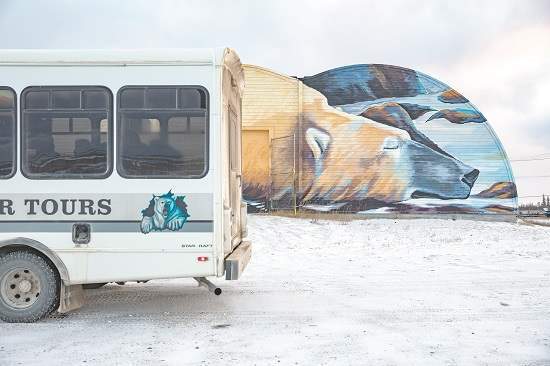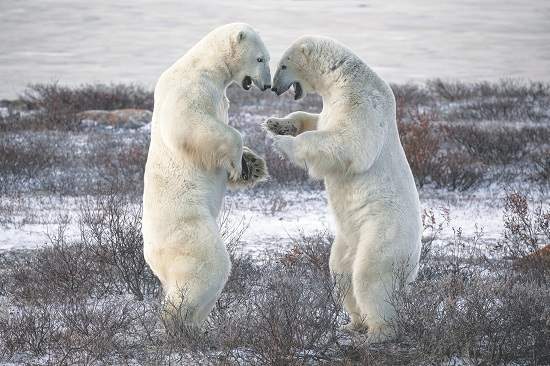CHURCHILL, Manitob — This is not another story about saving Hudson Bay’s polar bears. It’s too late for that. This is a story about what comes next for a small town that bills itself as the Polar Bear Capital of the World.
اضافة اعلان
In Churchill, an isolated town perched on the southern edge of the Arctic, climate change is not a looming danger. It imbues daily life. It is broken sewer lines and taller trees, longer summers and bigger snowstorms and moose where caribou used to go. Most of all, it is the fear that Americans won’t come visit anymore.
 A tour group visits a polar bear holding facility known as “bear jail” near the airport in Churchill, Manitoba, Canada, October 31, 2021. (Photo: NYTimes)
A tour group visits a polar bear holding facility known as “bear jail” near the airport in Churchill, Manitoba, Canada, October 31, 2021. (Photo: NYTimes)
Yet the mood in Churchill is surprisingly sunny. If people aren’t exactly cheering for climate change, many are focused on the opportunities global warming could bring to this cold-weather town. The polar bears are in trouble. The people dream of building a maritime city.
As sea ice melts away, Michael Spence, Churchill’s longtime mayor, says the town’s future is as an outlet for the grain grown on Canada’s western plains and the minerals that will be mined from its thawing northern expanses.
“At one point, we would have been afraid of climate change,” he said. “It doesn’t matter where you’re situated in the world — the threats are real. But you’ve got to look for the wins in all of this. You’ve got to be able to sleep at night.”
After decades of dire predictions, amid mounting evidence the warnings are coming true, there is still no sign that humans collectively are willing to make the kinds of changes necessary to limit the rise of global temperatures. In his 2019 book, “The Wizard and the Prophet,” science writer Charles C. Mann described a long-running argument between those who believe humans can survive in the long term only by accepting the limits of nature and those who believe humans can survive by reshaping nature. Wittingly or otherwise, we are placing our chips in the second basket.
World leaders gathered in Glasgow, Scotland, for the latest international conference on climate change have exchanged somber speeches but few significant commitments — certainly nothing commensurate with the challenge. If humans do succeed in limiting climate change or in surviving its effects, we will endure through innovation, not through moderation.
For Churchill, innovation is the only reasonable course. What can one town do to prevent change? But it is also true that global warming is likely to continue because even in the places facing the greatest threats, like Churchill, it is only human to doubt the worst will come, to believe we can adapt and to see the opportunities more clearly than the dangers.
 A child goes trick-or-treating as an Among Us character on Halloween in Churchill, Manitoba, Canada, October 31, 2021. (Photo: NYTimes)
A child goes trick-or-treating as an Among Us character on Halloween in Churchill, Manitoba, Canada, October 31, 2021. (Photo: NYTimes)
In 2014, a Canadian doctor visiting Churchill from southern Ontario took a photograph of climate change. It shows a red fox holding an arctic fox in its mouth, the blood of the smaller creature staining its snow-white fur.
Warmer weather is endangering Arctic species, in part by opening the gates for other animals, like red foxes, wolves and brown bears, as well as a host of smaller species, to move north. “We haven’t found anything that isn’t changing” in the Hudson Bay ecosystem, said David Barber, a professor at the University of Manitoba who studies climate change as scientific director of the Churchill Marine Observatory. “From the viruses and the bacteria right up to the whales, every single thing is being affected by climate change.”
That includes the local celebrities: Ursus maritimus, or polar bears.
One immediate impact of global warming is that the bears are spending more time around Churchill as the sea ice forms later in the year and melts earlier.
On land, polar bears lose about 1kg of their weight each day. As ice season shrinks, the bears face the double pain of fewer days of hunting and more days of fasting. Between 1980 and 2019, the weight of the average pregnant polar bear in the Churchill region declined by 15 percent, according to Nick Lunn, a Canadian government scientist. New births are in decline. The number of polar bears in western Hudson Bay fell by 30 percent from 1987 to 2016, and some experts think the population already is in terminal decline.
Some bears may survive, at least for a time, by moving farther north. But over the coming decades, if greenhouse gas emissions continue to build at the current pace, the disappearance of polar bears from the Hudson Bay region is inevitable, according to a 2020 study conducted by scientists at Polar Bears International, a research and advocacy group. Steven Amstrup, its chief scientist, said it’s not too late.
“I am confident that holding the global temperature rise below 2 degrees Celsius will preserve polar bears in parts of their current range,” he said. That is the goal nations set at the Paris climate meetings in 2015. But the commitments that nations have made are inadequate to achieve that goal. Scientists estimate global temperatures are on pace to rise by roughly 3 oc Celsius above the preindustrial norm by the end of the century.
 Polar bears spar as a way of exercising to prepare for their hunting season in the Churchill Wildlife Management Area in Churchill, Manitoba, Canada, November 1, 2021. (Photo: NYTimes)
Polar bears spar as a way of exercising to prepare for their hunting season in the Churchill Wildlife Management Area in Churchill, Manitoba, Canada, November 1, 2021. (Photo: NYTimes)
There’s not a lot of sentimentality about polar bears in Churchill. It’s hard to mourn the loss of the bears while they’re ubiquitous. Indeed, many locals say the bears have become bolder and more visible in recent years, which may be because the bears are hungrier.
In the late 19th century, grain farmers on Canada’s western plains, frustrated by the long haul to the Atlantic, turned their eyes to Canada’s northern ocean.
The government of Manitoba decided to build a grain port at Churchill, an old fur-trading post set on a narrow granite ridge that runs for about 15km along the edge of Hudson Bay.
At the western end of the ridge is the mouth of the Churchill River, a natural harbor sheltered from storms and deep enough to accommodate cargo ships. Because the world is round, the Churchill route to Europe is shorter than sending grain from the Great Plains through the Eastern Seaboard. When the new railroad and port opened in 1931, locals boasted that it was a shorter trip to Liverpool than from Montreal.
Churchill’s ice-free shipping season, which then ran from early August to early October, was brief but busy. In 1974, 25 million bushels of barley moved through Churchill — about one-fifth of the barley Canada exported that year.
During the Cold War, the Canadian and U.S. governments also built a number of military facilities around Churchill, including an airfield and a rocketry range.
The population peaked at around 5,000, including those living on the bases.
The end of the Cold War and the rise of agribusiness firms that concentrated shipping at Canada’s largest ports gradually shut down both of Churchill’s economic engines, and people drained away. In 1997 a US railroad entrepreneur named Pat Broe persuaded the Canadian government to transfer ownership of the port to his company, Omnitrax, in exchange for a nominal payment of 10 Canadian dollars. He said that Churchill was on the cusp of a new era as global warming extended the northern shipping season and opened new routes, like a polar passage connecting Churchill to Russia’s Arctic ports.
In May 2017, after a winter of heavy snows, meltwater floods washed out the rail line in more than a dozen places. Omnitrax soon announced that it was pulling out. The company blamed climate change for the failure of an investment that was made in the expectation of climate change.
“To fix things in this era of climate change — well, it’s fixed, but you don’t count on it being the fix forever,” Ron Mitchell, a railway engineer hired by Omnitrax as a consultant, said at a briefing convened to explain the decision. “Things are changing that we can’t arrest or change or govern.”
From trading post to grain port to Cold War garrison town to eco-tourism destination, Churchill has a long history of adaptation. Spence, the mayor, says the town just needs to do it again. In 2018 the Canadian government spent $74 million to acquire the port and rail line and then transferred both to a consortium of local communities and First Nations bands. The government is pumping still more money into strengthening the rail line. Spence says that grain shipments should start flowing through the port again next year.
That vision has some powerful supporters in the Canadian establishment, who see the economic development of the Arctic as a key part of the nation’s future. Churchill has enough housing and water and sewer capacity for 3,500 people — about four times the present population. It has a large community center that includes a hospital, elaborate athletic facilities and the local public school, as well as a movie theater and other cultural amenities. It has a railroad, a seaport and an airport that were built for the needs of a larger community. It seems inevitable that people will move north as the climate changes. Why not here?
The town is also working to find replacements for the polar bears. Penny Rawlings and her husband, Keith, moved to Churchill from Nunavut in the 1970s and opened the Arctic Trading Company, which employs Indigenous people to make moccasins, soapstone carvings and other traditional handicrafts. Her hope for the future is that people will come to see the Northern Lights — a natural wonder that has the advantage of being unaffected by climate change. “It’s something we can rely on,” Penny Rawlings said.
David Daley, a dog musher who offers sled tours, has invested in carts with wheels — a little like Rollerblades, though the wheels are much bigger — so he can offer tours when there’s not enough snow for a sled.
Local tour operators hope that people will come to Churchill in the spring to see birds and in the summer to see belugas calve in the mouth of the river.
But unlike past disruptions, climate change isn’t just upending Churchill’s economy. It is quite literally tearing the town apart. Delayed winters have increased the intensity of storms, which draw strength from the open water.
Elsie Hyska, who owns a summer cottage on the bay, said she now has to secure the window shutters with screws in the fall. Lightning storms were once so unusual that the town’s power lines were built without standard protections. Now lightning regularly knocks out power.
Warmer weather also is thawing the permafrost, undermining building foundations and breaking the town’s water and sewer lines.
It’s often said that we aren’t destroying the planet; we are destroying our ability to exist on the planet. But what if we are merely destroying the ability of others to exist on the planet? What if Churchill emerges as a thriving port city facilitating the distribution of wheat and minerals around the world and everything that is distinctive and particular about the Arctic is erased in the process?
Does that count as a victory? Will our descendants consider that good enough?





